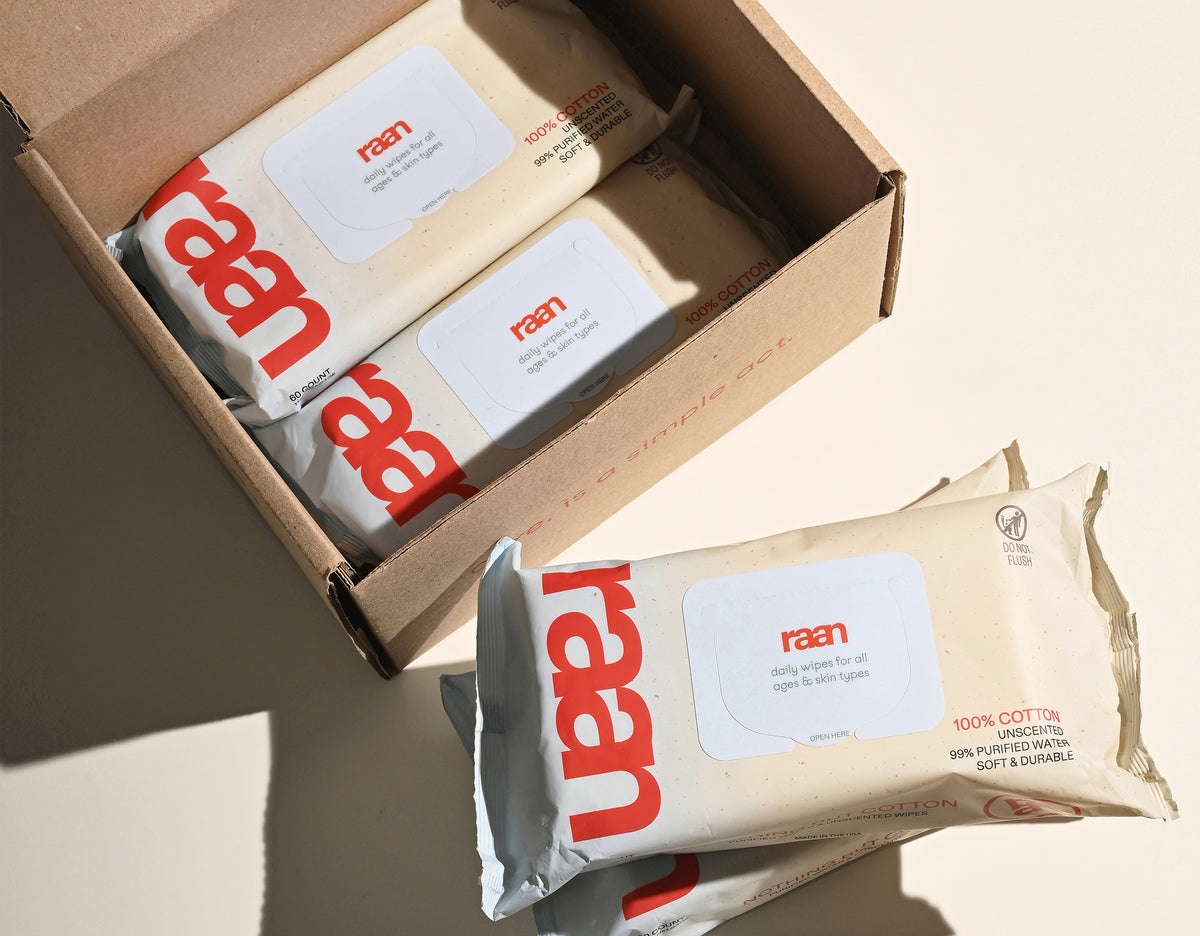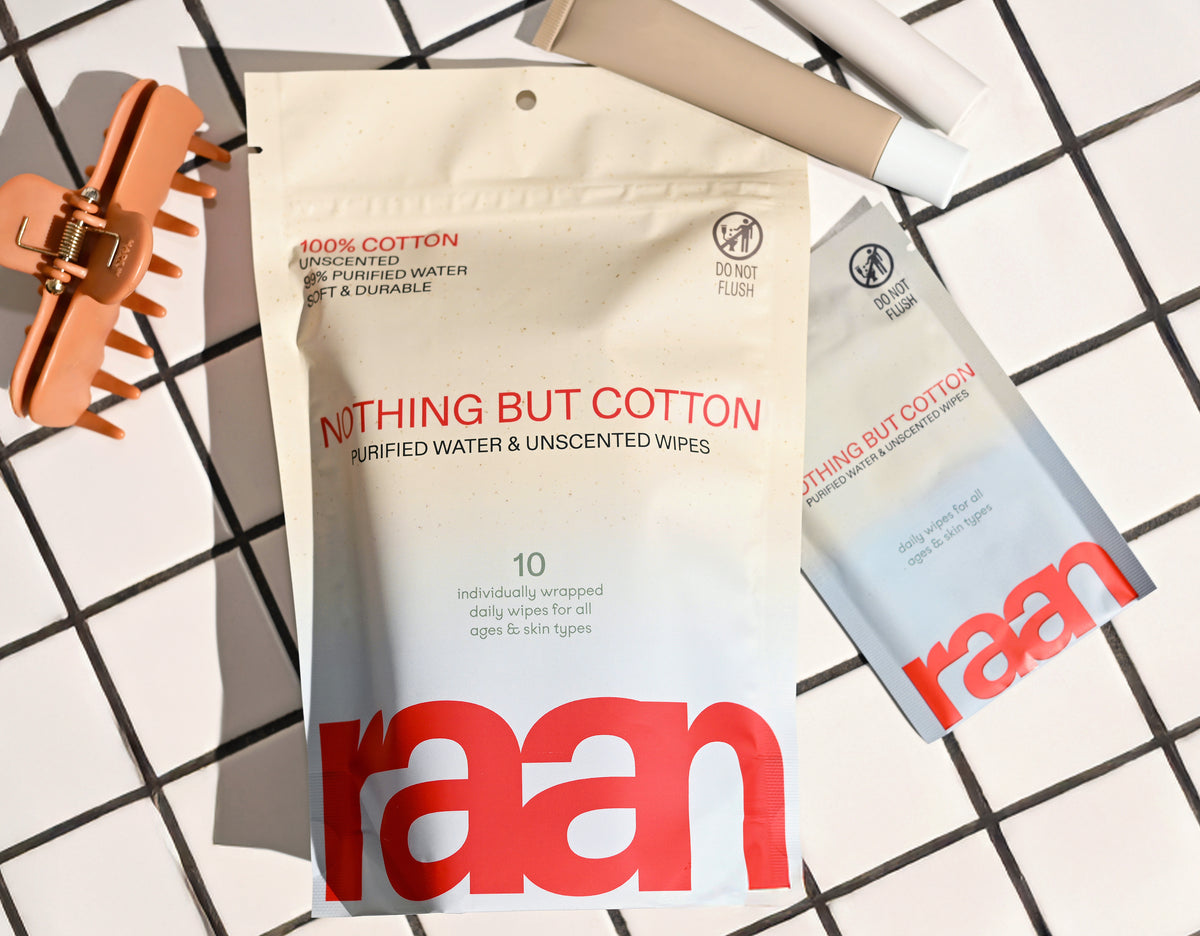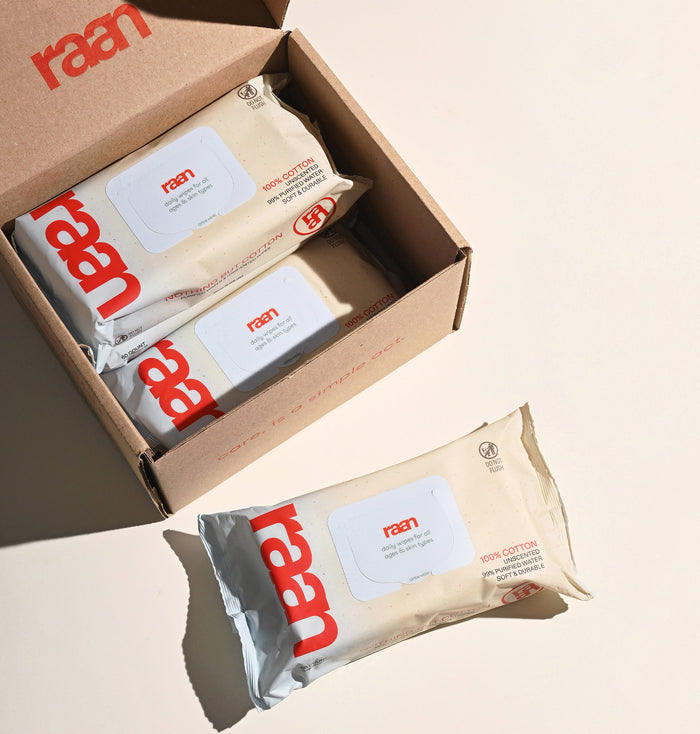The wipes industry is changing fast, and compostable wipes are leading the charge. If you're tired of mystery ingredients, plastic fibers, and vague "eco-friendly" claims, you're not alone. We've spent years digging into what makes wipes truly safe for skin and planet - and the truth is both simpler and more complex than most brands want you to know.
Key Takeaways
- The wipes industry is rapidly evolving with compostable wipes at the forefront.
- Many wipes contain mystery ingredients, plastic fibers, and unclear eco-friendly claims.
- True safety for both skin and the environment requires careful scrutiny.
- Understanding what makes wipes genuinely compostable is more complex than it appears.
- Consumers are increasingly seeking transparency and authenticity in wipe products.
Table of Contents
- What Makes Wipes Truly Compostable?
- Home vs. Commercial Composting: Know the Difference
- Certifications That Actually Matter
- Performance vs. Planet: The Real Trade-offs
- Ingredient Transparency: What to Demand
- Making Smart Purchasing Decisions
- Proper Disposal: Maximizing Environmental Benefits
- Final Recommendations: Choosing Your Path
Quick Answer
Compostable wipes are made from 100% plant-based fibers like organic cotton, bamboo, or wood pulp that fully break down in composting conditions within weeks to months. Unlike biodegradable wipes that may contain plastics, truly compostable wipes use zero synthetic materials and feature minimal, transparent ingredients. Look for certifications like GOTS, FSC, or EWG Verified, and always check if they're home-compostable or require commercial composting facilities.
Here's what we've learned: not all compostable wipes are created equal. Some break down in your backyard compost bin, others need industrial facilities. Some are gentle enough for newborn skin, others might irritate. And despite what marketing claims suggest, the difference between "compostable," "biodegradable," and "flushable" matters more than you think.
Whether you're a new parent overwhelmed by product labels, someone with sensitive skin who's been burned by harsh formulas, or simply trying to make better choices for your home, this guide cuts through the noise. We'll walk you through the five key facts that separate genuinely compostable wipes from greenwashed alternatives - and why the material matters as much as what's soaked into it.
What Makes Wipes Truly Compostable?
Real compostable wipes start with the base material - and this is where most brands fall short. The wipe itself must be made from 100% plant-based fibers with zero synthetic binders, plastic reinforcements, or chemical processing that prevents breakdown.
Key fact: Many "biodegradable" wipes contain up to 20% plastic fibers to add strength, which means they never fully decompose.
The gold standard materials include:
- Unbleached, 100% cotton - naturally soft, chemical-free processing, breaks down completely in home compost
- Bamboo fiber - antimicrobial properties, rapid growth cycle, industrial compost preferred
- FSC-certified wood pulp - sustainably sourced, varies in softness, typically commercial compost only
But here's what most people miss: the liquid formula matters just as much as the wipe material. A cotton wipe soaked in synthetic preservatives, fragrances, or harsh cleansers won't compost properly - and it's definitely not safe for sensitive skin.
Truly compostable wipes use minimal, transparent ingredients. We're talking 99% purified water, food-grade preservatives like sodium benzoate, and gentle plant extracts like organic aloe. That's it. No mystery "cleansing complex" or "botanical blend" that could mean anything.
This transparency isn't just better for composting - it's better for your skin. When you know exactly what's in your wipes, you can make informed choices about what touches your family's skin dozens of times a day. And when those ingredients are as simple as water, aloe, and food-grade preservatives, you get cleaning power without the chemical complexity that causes irritation.
Home vs. Commercial Composting: Know the Difference

Not all compostable wipes work in your backyard bin. This distinction is crucial - and it's often buried in fine print or ignored entirely by brands hoping you won't notice.
Home-compostable wipes break down in typical backyard compost conditions: temperatures around 140-160°F, regular turning, balanced carbon and nitrogen. These are usually made from unbleached cotton or specially processed bamboo, with the simplest possible liquid formulas.
Commercial-compostable wipes need industrial facilities that reach 160°F+ for extended periods. They might use thicker plant fibers or slightly more complex preservation systems that require higher heat to fully break down.
Reality check: If your city doesn't have commercial composting pickup, those "compostable" wipes are heading to the landfill anyway. Always check your local waste management options before switching.
The certification language tells you which is which. Look for phrases like "meets ASTM D6400 standards for home composting" or "OK compost HOME certified." If you only see general "compostable" claims without specific certifications, assume they need commercial facilities.
We've found that unbleached, 100% cotton wipes with minimal ingredients - like purified water, organic aloe, and food-grade preservatives - consistently perform best in home compost systems. The natural cotton fibers break down quickly, and the simple liquid formula doesn't interfere with your compost's microbial activity.
Pro tip: Even home-compostable wipes should go in your "brown" (carbon-rich) compost materials, not your "green" (nitrogen-rich) pile. The cotton provides carbon structure that helps your compost maintain proper balance.
Certifications That Actually Matter
The certification landscape for compostable wipes is cluttered with logos that sound impressive but mean little. After years of decoding these labels, we've learned which certifications actually guarantee what they claim - and which ones are just marketing noise.
Key fact: Only three certifications reliably indicate truly compostable wipes: ASTM D6400 (commercial), ASTM D6868 (home), and OK compost HOME by TÜV AUSTRIA.
Here's what each certification actually tests:
- ASTM D6400
- Commercial composting standard. Requires 90% biodegradation within 180 days at industrial facility temperatures (160°F+). This is the most common certification you'll see.
- ASTM D6868
- Home composting standard. Much stricter - requires breakdown in typical backyard conditions within 365 days. Rare but valuable if you have home compost.
- OK compost HOME
- European standard for home composting. Similar to D6868 but often more rigorous testing. Gold standard for backyard composting.
Beyond compostability, look for these material and safety certifications:
- EWG Verified - ingredients screened against Environmental Working Group's strictest standards for human health
- GOTS (Global Organic Textile Standard) - ensures organic cotton meets environmental and social criteria throughout supply chain
- FSC Certified - wood pulp from responsibly managed forests
- OEKO-TEX Standard 100 - tests for harmful substances in textiles
Red flag: Avoid wipes that only claim "biodegradable" or "eco-friendly" without specific certifications. These terms have no legal definition and often hide plastic content or synthetic processing.
The most trustworthy brands display multiple certifications and explain exactly what each one means. They're not hiding behind vague environmental claims - they're proving their products work through third-party testing.
For families with sensitive skin, EWG Verified certification matters most. It means every single ingredient has been evaluated for safety, with no exceptions for "proprietary blends" or "fragrance complexes." When you're using wipes dozens of times daily on faces and diaper areas, that transparency isn't just nice to have - it's essential.
Performance vs. Planet: The Real Trade-offs

The honest truth about compostable wipes? Some work beautifully. Others fall apart in your hands or dry out within days of opening. The key is understanding which compromises matter for your specific needs.
Compostable Wipe Advantages
- Zero microplastics released during use or disposal
- Gentler on sensitive skin due to minimal processing
- Transparent ingredient lists you can actually understand
- Complete breakdown in proper composting conditions
- Often thicker and more absorbent than plastic alternatives
Potential Drawbacks
- Higher upfront cost (typically 20-40% more expensive)
- May dry out faster without plastic packaging barriers
- Limited availability in many retail stores
- Composting infrastructure not available everywhere
- Some plant fibers can feel rougher than synthetic materials
The performance gap has narrowed significantly in recent years. Unbleached, 100% cotton wipes - when properly formulated with the right moisture content and preservation system - match or exceed traditional wipes for cleaning power and durability.
We've found that the best compostable wipes share certain characteristics: they're thick enough to handle serious messes without tearing, stay moist for weeks after opening, and feel soft against skin despite being made from natural fibers. The liquid formula matters enormously here - 99% purified water with organic aloe and food-grade preservatives creates the ideal balance of gentleness and effectiveness.
Pro tip: Store compostable wipes with the package sealed tightly and avoid extreme temperatures. Natural materials are more sensitive to environmental conditions than synthetic alternatives.
Cost-wise, the premium for truly compostable wipes reflects the higher-quality materials and more complex supply chain. Organic cotton costs more than plastic fibers. EWG-verified ingredients cost more than conventional preservatives. But when you factor in the reduced environmental impact and safer ingredient profile, many families find the extra expense worthwhile.
The bigger question isn't whether compostable wipes perform well - it's whether your local waste system can actually compost them. Without proper disposal infrastructure, even the most perfectly compostable wipe becomes expensive landfill waste. Research your options before making the switch.
Ingredient Transparency: What to Demand
The ingredient list tells you everything about whether a wipe is truly safe for daily use. After reviewing hundreds of formulations, we've learned that the shortest lists are usually the safest - and the most honest about what's actually inside.
Here's what genuine transparency looks like in compostable wipes:
Clean Formula Example
Purified Water (99%), Organic Aloe (moisturizer), Sodium Benzoate (food-grade preservative), Potassium Sorbate (food-grade preservative), Ethylhexylglycerin (skin-conditioning), Citric Acid (pH balance)
Every ingredient serves a clear purpose. No mystery "cleansing complex" or "botanical extract blend" that could hide synthetic additives. No fragrance system that might contain dozens of unlisted chemicals. Just water, gentle plant extracts, and preservation ingredients you'd find in food.
Compare this to conventional wipes that list 15-20 ingredients including "fragrance," "cleansing agents," and "conditioning polymers." Those vague terms can legally hide hundreds of individual chemicals, many of which haven't been tested for safety on sensitive skin.
Critical insight: Food-grade preservatives like sodium benzoate and potassium sorbate are actually gentler and safer than many "natural" preservation systems that rely on essential oils or botanical extracts.
The most trustworthy brands explain not just what's in their wipes, but why each ingredient is necessary and how it's sourced. They're transparent about their preservation system because they know it's safe. They list the exact type of cotton or plant fiber because they're proud of their material choices.
For families dealing with eczema, allergies, or highly sensitive skin, this transparency isn't optional. When you know exactly what's touching your skin, you can make informed decisions and avoid ingredients that have caused problems in the past. Vague ingredient lists make this impossible - and that's often intentional.
This ingredient honesty extends to what's not in the wipes too. Truly compostable options are free from synthetic fragrances, parabens, sulfates, alcohol, and chlorine processing. They don't need these harsh additives because the base materials are naturally gentle and effective.
Making Smart Purchasing Decisions

The compostable wipe market has exploded over the past few years, but not all options deliver on their promises. After testing dozens of brands and analyzing ingredient lists, we've identified the key factors that separate genuinely effective compostable wipes from expensive disappointments.
Essential checklist: Look for unbleached cotton or bamboo fiber, EWG-verified ingredients, specific compostability certifications, and transparent preservation systems using food-grade ingredients.
Price shouldn't be your primary deciding factor, but it often reflects material quality. Genuine compostable wipes typically cost 20-40% more than conventional options because organic cotton and bamboo fibers are significantly more expensive than plastic alternatives. When a "compostable" wipe costs the same as regular wipes, investigate the materials closely - it may contain plastic fibers or synthetic processing that compromises compostability.
Packaging matters more than most people realize. The best compostable wipes come in pouches that use 70% less plastic than hard-lid containers, with post-consumer recycled content and fully recyclable outer boxes. This packaging approach keeps wipes moist while minimizing environmental impact - a balance that requires thoughtful engineering.
What to Prioritize
- ASTM D6400 or D6868 certification for verified compostability
- EWG Verified ingredients for safety transparency
- Unbleached, 100% cotton or bamboo construction
- Minimal ingredient list with clear purpose for each component
- Food-grade preservatives instead of synthetic alternatives
Red Flags to Avoid
- Vague claims like "eco-friendly" without specific certifications
- Ingredient lists with "fragrance" or "cleansing complex"
- Prices significantly below market average for certified options
- No information about fiber source or processing methods
- Marketing focused on trends rather than material science
Consider your disposal options before purchasing. Home-compostable wipes require active composting systems and proper carbon-nitrogen ratios to break down effectively. If you don't compost at home and your municipality doesn't accept compostable materials, even the most perfectly designed wipe becomes landfill waste - though it will still biodegrade faster than plastic alternatives.
For families using wipes multiple times daily, durability and moisture retention become critical factors. The best formulations maintain effectiveness for weeks after opening, with thick enough material to handle serious messes without tearing. This performance comes from careful balance of water content, natural moisturizers like organic aloe, and preservation systems that prevent bacterial growth without harsh chemicals.
Test small packages first, especially if you have sensitive skin in the family. Even the gentlest natural materials can cause reactions in some individuals, and it's better to discover compatibility issues with a small investment.
Proper Disposal: Maximizing Environmental Benefits
Buying compostable wipes is only half the environmental equation. How you dispose of them determines whether they actually deliver on their sustainability promise or simply become expensive landfill waste.
Home composting works best for wipes certified under ASTM D6868 or OK compost HOME standards. These break down in typical backyard compost conditions within 12 months, but success depends on maintaining proper compost ratios. Wipes are considered "green" or nitrogen-rich materials, so balance them with "brown" carbon materials like dried leaves or cardboard.
Home Composting Guidelines
Do compost: Wipes used for food messes, general cleaning, face and hand wiping
Don't compost: Wipes contaminated with human waste, harsh cleaning chemicals, or pet waste
Compost temperature: Maintain 140-160°F for optimal breakdown
Municipal composting programs vary widely in what they accept. Many commercial facilities can handle ASTM D6400-certified wipes, even those contaminated with organic waste, because industrial composting reaches higher temperatures and maintains controlled conditions. Contact your local program to understand their specific guidelines.
If composting isn't available in your area, compostable wipes still offer environmental advantages in landfills. Unlike plastic-based wipes that persist for decades, plant-based materials will eventually biodegrade, even in less-than-ideal conditions. They won't release microplastics during breakdown and generally decompose within 2-5 years rather than 20-50 years. They won't release microplastics during breakdown and generally decompose within 2-5 years rather than 20-50 years.
Critical reminder: Never flush any wipes, even those labeled "flushable." Compostable materials can still cause plumbing blockages and wastewater treatment problems.
For families generating large volumes of soiled wipes, some companies offer collection programs that ensure proper commercial composting. These services pick up used wipes and guarantee they reach appropriate facilities, removing the guesswork from disposal decisions.
The environmental benefits compound when you consider the full lifecycle. Compostable wipes made from organic cotton or bamboo support sustainable agriculture, avoid plastic production entirely, and create nutrient-rich compost that can improve soil health. This closed-loop system represents a fundamental shift from the linear "take-make-waste" model of conventional wipes. This closed-loop system represents a fundamental shift from the linear "take-make-waste" model of conventional wipes.
Final Recommendations: Choosing Your Path
Compostable wipes represent a meaningful step toward reducing plastic waste and chemical exposure in daily care routines. But they're not automatically the right choice for every family or situation.
Choose compostable wipes if you have access to proper disposal infrastructure, prioritize ingredient transparency, and don't mind paying a premium for environmental benefits. They excel for families with sensitive skin, those committed to reducing plastic consumption, and households already engaged in composting or zero-waste practices.
The most effective compostable wipes combine unbleached, 100% cotton construction with minimal, EWG-verified formulations. Look for brands that explain their material sourcing, display multiple certifications, and provide clear disposal guidance. These companies understand that true sustainability requires transparency at every level.
Bottom line: Compostable wipes work best when you can actually compost them. Without proper disposal options, they're still preferable to plastic alternatives but won't deliver their full environmental potential.
For maximum impact, pair compostable wipes with other sustainable practices: choose concentrated formulas that reduce packaging, buy in bulk when possible, and consider reusable cloth wipes for routine cleaning tasks. The goal isn't perfection - it's progress toward products that align with your values and actually work in your daily routine.
The compostable wipe market will continue evolving as more families demand transparency and sustainability. Early adopters help drive innovation and make these products more accessible for everyone. By choosing thoughtfully and disposing properly, you're supporting a shift toward genuinely cleaner alternatives that don't compromise on performance or safety. By choosing thoughtfully and disposing properly, you're supporting a shift toward genuinely cleaner alternatives that don't compromise on performance or safety.
Frequently Asked Questions
What certifications verify that wipes are compostable?
Compostable wipes are typically verified by certifications like the Biodegradable Products Institute (BPI) or TÜV Austria’s OK Compost label. These certifications ensure the wipes meet strict standards for breaking down safely in compost environments without leaving harmful residues.
Can I compost wipes in a backyard pile or only in industrial facilities?
Most compostable wipes require industrial composting facilities to break down fully because these environments maintain higher temperatures and controlled conditions. While some may degrade in backyard compost piles, it usually takes much longer and may not result in complete decomposition.
How long do compostable wipes take to break down?
In industrial composting settings, compostable wipes generally break down within 90 to 180 days. Backyard composting can extend that timeframe significantly, often taking several months or longer depending on temperature, moisture, and microbial activity.
Do compostable wipes need special disposal conditions?
Yes, compostable wipes require disposal in designated industrial composting bins or facilities to ensure proper breakdown. They should not be thrown in regular trash or flushed, and home composting is usually not sufficient for complete decomposition.
Are compostable wipes as strong as regular wipes?
Compostable wipes can be just as strong and functional as regular wipes, but their durability depends on materials used-often plant-based fibers-and manufacturing processes. Some may feel different in texture but are designed to hold up well during use without relying on plastics or synthetic fibers.






